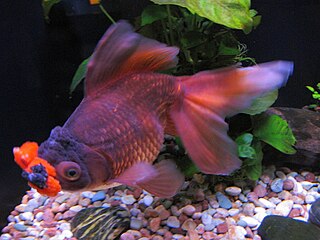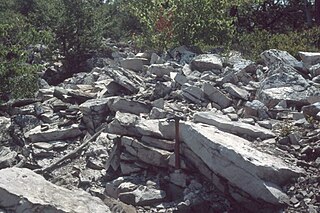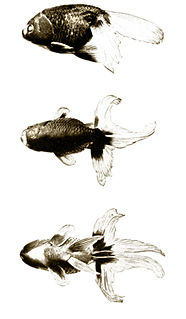
Shenandoah County is a county located in the Commonwealth of Virginia. As of the 2010 census, the population was 41,993. Its county seat is Woodstock. It is part of the Shenandoah Valley region of Virginia.

Pompoms or pompon or hana fusa are a type of fancy goldfish that have bundles of loose fleshy outgrowths between the nostrils, on each side of the head.

The Murasame-class destroyer is a class of destroyers, serving with the Japan Maritime Self-Defense Force (JMSDF). This is the first class of the second-generation general-purpose destroyers of the JMSDF.

Japanese words of Dutch origin started to develop when the Dutch East India Company initiated trading in Japan from the factory of Hirado in 1609. In 1640, the Dutch were transferred to Dejima, and from then on until 1854 remained the only Westerners allowed access to Japan, during Japan's "sakoku" seclusion period.
Cedar Creek is a 40.5-mile-long (65.2 km) tributary stream of the North Fork Shenandoah River in northern Virginia in the United States. It forms the majority of the boundary between Frederick and Shenandoah counties. Cedar Creek's confluence with the North Fork Shenandoah is located at Strasburg.

The Silurian Tuscarora Formation — also known as Tuscarora Sandstone or Tuscarora Quartzite — is a mapped bedrock unit in Pennsylvania, Maryland, West Virginia, and Virginia, USA.

The Mississippian Pocono Formation is a mapped bedrock unit in Pennsylvania, Maryland, and West Virginia, in the United States. It is also known as the Pocono Group in Maryland and West Virginia, and the upper part of the Pocono Formation is sometimes called the Burgoon Formation or Burgoon Sandstone in Pennsylvania. The Pocono is a major ridge-former In the Ridge-and-Valley Appalachians of the eastern United States

The Shukin is Ranchu-like goldfish developed from Ranchu and Oranda at the end of the 19th century in Japan.
The Devonian Scherr Formation is a mapped bedrock unit in Pennsylvania, Maryland, Virginia and West Virginia.

The Devonian Foreknobs Formation is a mapped bedrock unit in Pennsylvania, Maryland, Virginia, and West Virginia.

The Devonian Brallier Formation is a mapped bedrock unit in Pennsylvania, Maryland, West Virginia, and Virginia.

Florence Aby Blanchfield was a United States Army Colonel and superintendent of the Army Nursing Corps, from 1943 to 1947. She was awarded the Distinguished Service Medal in 1945, and the Florence Nightingale Medal by the International Red Cross in 1951. In 1947 Blanchfield became the first woman to receive a military commission in the regular army.

The Antietam Formation or Antietam Sandstone is a geologic formation in Pennsylvania, Maryland and West Virginia. It is largely quartz sandstone with some quartzite and quartz schist. It preserves Skolithos trace fossils dating back to the Cambrian Period.
The Swift Run Formation is a geologic formation in Virginia and West Virginia. It dates back to the Neoproterozoic.
The Waynesboro Formation is a limestone, dolomite, and sandstone geologic formation in Virginia, Maryland, Pennsylvania and West Virginia. It some areas it is composed of limestone and dolomite. The Waynsboro Formation is one of the formations that make up the Shenandoah Valley. It dates back to the Cambrian period and is not considered fossiliferous.
The Wells Creek Formation is a geologic formation in West Virginia. It dates back to the Ordovician period.
This page is based on this
Wikipedia article Text is available under the
CC BY-SA 4.0 license; additional terms may apply.
Images, videos and audio are available under their respective licenses.











